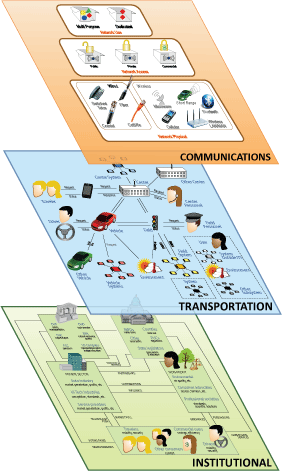Overview
 The National ITS Architecture provides a common framework for planning, defining, and integrating intelligent transportation systems. It is a mature product that reflects the contributions of a broad cross-section of the ITS community (transportation practitioners, systems engineers, system developers, technology specialists, consultants, etc.). The architecture defines:
The National ITS Architecture provides a common framework for planning, defining, and integrating intelligent transportation systems. It is a mature product that reflects the contributions of a broad cross-section of the ITS community (transportation practitioners, systems engineers, system developers, technology specialists, consultants, etc.). The architecture defines:
- The functions (e.g., gather traffic information or request a route) that are required for ITS
- The physical entities or subsystems where these functions reside (e.g., the field or the vehicle).
- The information flows and data flows that connect these functions and physical subsystems together into an integrated system.
If you would prefer a summary document that you can print and read, a brief document is available that presents the key architecture concepts.
Source Organization Location
Washington
DC
Operations Area of Practice
Integrated ITS Deployment
Communications
Connected Vehicles
Configuration Management
Detection Systems
Real Time Traveler Information
ITS standards and specifications
Systems engineering
Transportation Management Centers (TMC / TOC)
Decision Criteria for ITS Device Type and Location
Automatic Vehicle Location (AVL)
ITS System architecture
Risk Management
Standards and Specifications
Business Processes/Policies and Procedures
Cyber security
Organizational Capability Element
Planning
System Architecture / Engineering
Standards and Interoperability
Content Type
Standards & Recommended Practices
Role in Organization
Senior Engineer
Researcher/Academic
Principal Engineer
Director / Program Manager
Technician
Engineer
Associate Engineer
Publishing Organization
OST ITS JPO